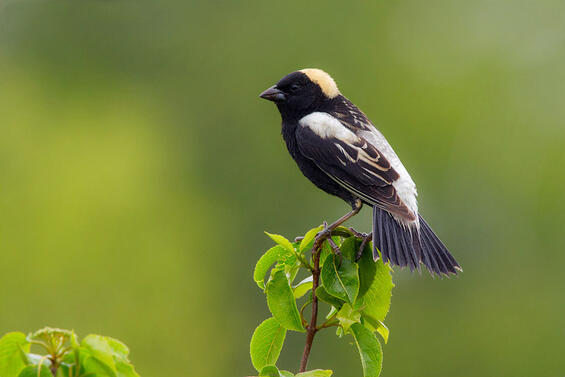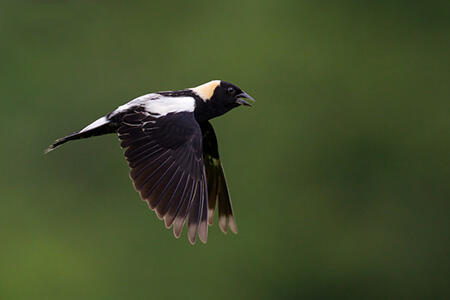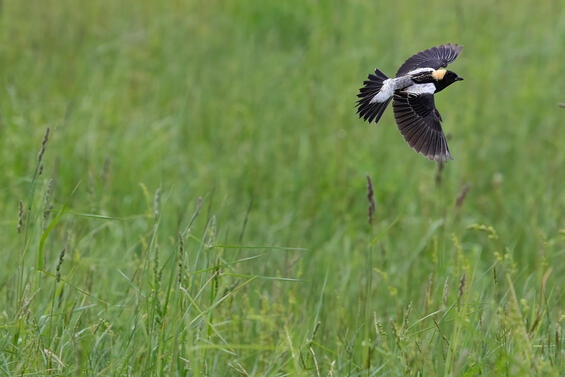- Scientific name: Dolichonyx oryzivorus
Species of Greatest Conservation Need (MA State Wildlife Action Plan)
Description

Bobolink
The bobolink is a medium-sized blackbird, 16–18 cm (6.3–7.1 in) long, that nests in grassland habitat throughout the northeast. The female is a subdued patchwork of streaked earthtones. The male is a striking black bird with yellow crown and white wings and rump patch. The male’s song is often described as a long string of bubbly notes that pours forth from the bird as it perches on fenceposts or hovers above the grassland.
Life cycle and behavior
Bobolinks arrive to their grassland breeding grounds in Massachusetts during the first week of May and quickly establish territories. The female weaves a nest of dead grasses on the ground where she lays generally 4-5 eggs. Eggs hatch in around 12 days, and chicks leave the nest around 10 days after hatching. Males will often hold a territory with multiple females and nests are often comprised of eggs fertilized by different males. Males assist with feeding the young, and once fledged, family groups will congregate before making the long migration to South America. Bobolinks forage on invertebrates and seeds during the nesting period and rice and other grains on their wintering grounds in the pampas of South America (Martin et al. 1995).
Population status

Although bobolinks have shown strong declines throughout eastern North America, in Massachusetts, the Breeding Bird Survey and Breeding Bird Atlas depict a more stable population (Sauer et al 2014, Walsh and Petersen 2013).
Distribution and abundance
Bobolinks breed in grassland habitat across much of the northern United States and southern Canada.
Habitat
Bobolinks nest in large hayfields comprised of cool season grasses. Grassland and agricultural areas are used by bobolinks during migratory stopovers and as overwintering habitat.
Healthy habitats are vital for supporting native wildlife and plants. Explore habitats and learn about conservation and restoration in Massachusetts.

Threats
On the breeding grounds, the main threats to bobolink populations are loss of habitat and hayfield mowing during the nesting period. Grassland habitat has declined dramatically in Massachusetts as it continues to be either developed or revert to forests. To maintain the remaining grasslands, fields should be mowed annually, but this activity is harmful to grassland birds if it is conducted during the primary nesting period (late May-mid-July). Harvesting hay when birds are nesting has been documented to result in 100% nesting failure (Perlut et al. 2006). Mowing often occurs 2-3 weeks earlier than in the past, and this is thought to be a major cause of their global decline. Habitat loss and hunting on the wintering grounds may also be an important contributing factor to population declines.
Predation by domestic cats has been identified as the largest source of mortality for wild birds in the United States with the number of estimated mortalities exceeding 2 billion annually. Cats are especially a threat to those species that nest on or near the ground.
An additional threat to the species is collisions with buildings and other structures, as approximately 1 billion birds in the United States are estimated to die annually from building collisions. A high percentage of these collisions occur during the migratory periods when birds fly long distances between their wintering and breeding grounds. Light pollution exacerbates this threat for nocturnal migrants as it can disrupt their navigational capabilities and lure them into urban areas, increasing the risk of collisions or exhaustion from circling lit structures or areas.
Conservation
Finding compatible schedules for the mowing of hayfields and the nesting cycles of bobolinks is the primary conservation challenge of bobolink conservation on the breeding grounds. Promote responsible pet ownership that supports wildlife and pet health by keeping cats indoors and encouraging others to follow guidelines found at fishwildlife.org.
Bird collision mortalities can be minimized by making glass more visible to birds. This includes using bird-safe glass in new construction and retrofitting existing glass (e.g., screens, window decals) to make it bird-friendly and reducing artificial lighting around buildings (e.g., Lights Out Programs, utilizing down shielding lights) that attract birds during their nocturnal migration.
References
Forbush, E. 1927. Birds of Massachusetts and Other New England States. Norwood Press. Norwood, MA.
Di Giacomo, A., A. Di Giacomo, and J. Contreras. 2005. Status and Conservation of the Bobolink in Argentina. USDA Forest Service Gen. Tech. Rep. PSW-GTR-191.
Martin, S.G., and T.A. Gavin. 1995. Bobolink (Dolichonyx oryzivorus), The Birds of North America Online (A. Poole, Ed.). Ithaca: Cornell Lab of Ornithology; Retrieved from the Birds of North America Online.
Perlut, N., A. Strong, T.M. Donovan, and N. Buckley. 2006. Grassland songbirds in a dynamic management landscape: behavioral responses and management strategies. Ecological Applications 16:2235-2247.
Sauer, J.R., J.E. Hines, J.E. Fallon, K.L. Pardieck, D.J. Ziolkowski, Jr., and W.A. Link. 2014. The North American Breeding Bird Survey, Results and Analysis 1966 – 2013. Laurel, MD.
Walsh, J. and W.R. Petersen. 2013. Massachusetts Breeding Bird Atlas 2. Massachusetts Audubon Society and Scott & Nix, Inc.
Contact
| Date published: | April 4, 2025 |
|---|